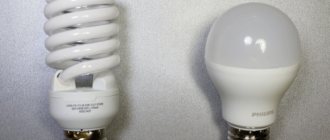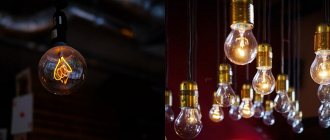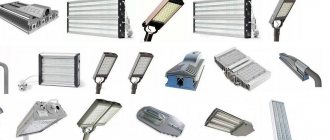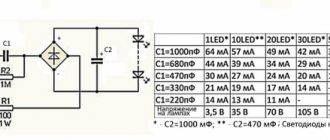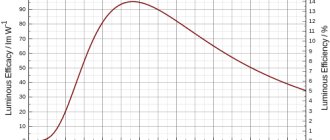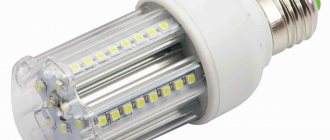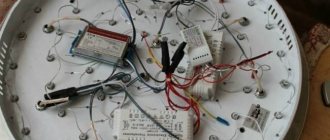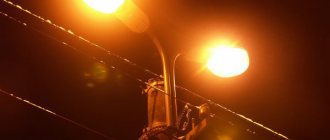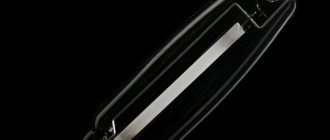There are certain requirements for such lamps that provide street and industrial lighting, illumination of transport routes and structures - a high level of color transmission and contrast of illuminated objects. These requirements are based on the safety conditions when performing work in these areas.
Currently, many organizations are switching in outdoor lighting from the use of gas-discharge lamps to the use of LED analogues. To correctly understand when and where it is appropriate to replace DRLs with LED lamps, you need to consider their characteristics.
Advantages and disadvantages
DLR is a high-pressure mercury arc fluorescent lamp, to which a special type of phosphor is added. Available in power ratings from eighty to one thousand watts. It has a color temperature of 3800 K. Efficiency is estimated at 40 lumens per watt. Works for 10 thousand hours. Has low color rendering.
DRL 250
Widely used for general street lighting, industrial workshops and any uncrowded places. That is, its main use is where color rendering is low and energy saving is high. The main advantage of such lamps is their high efficiency. Among the disadvantages, we can note the fact that ozone is released very intensively, ignition when turned on takes 7 minutes, re-ignition is possible after twenty minutes. In addition, in this lamp it is necessary to turn on the ballast choke, and the concentration of mercury vapor is sufficient to poison a person if the bulb is damaged.
The high pressure sodium tube arc lamp is an economical luminaire that is used for outdoor lighting. It is found on the street, highway, tunnel, train station, airport and industrial area.
The advantage lies in its efficiency, high luminous efficiency (efficiency is 30%) and a long service life - from 12 to 25,000 hours. One of the disadvantages is the rather long ignition time.
Note! In addition, such a lamp does not work well in bad weather conditions.
High efficiency of light flux from DRL lamps
Gas discharge and LED lamps: comparison
Replacing DRL lamps should not be carried out with a loss of quality lighting; to do this, you need to understand what parameters affect illumination when choosing a lamp: luminous flux, the value of which is measured in lumens (lm), and the second indicator for the characteristic - how many lumens are per 1 W lamp .
Light sources also differ in temperature; there is warm and cold light, the difference is shown in the photo:
In order to choose the right lamp, you need to understand how the luminous flux is calculated. To make things easier, you can use the formula:
- for LED sources - power × 80 lm/W;
- for DNAT (power 250 W) × 88 lm/W;
- for DRL (power 250 W) × 58 lm/W.
The luminous flux for gas-discharge light sources, measured in this way, can only be correct if the lamps operate for no more than 12 thousand hours, then the glow intensity drops.
DRL lamps
Let's consider DRL 250. This type of lamp is easy to produce compared to fluorescent light sources, but has worse color rendering of the illuminated object and light output compared to sodium devices. The advantage over HPS is the absence of high-voltage devices in the switching circuit, as well as better energy consumption parameters: they are more economical, there is less pulsation of the light flux.
DRL light source
HPS lamps
This type of lighting device is characterized by good luminous efficiency, regardless of the duration of operation of the lamp. Experts do not recommend using these light bulbs inside production facilities to illuminate large spaces due to the high pulsation of the light flux, as well as the deviation towards the red color of the emission spectrum - together, this affects the color perception of lighting objects.
Effective operation of sodium arc lamps is possible only under certain conditions:
- stable network voltage;
- lamp operation in the temperature range from –20 to +30 °C.
When luminaires with these lamps are used in other conditions, experts note a significant decrease in luminous efficiency and a decrease in the service life of lighting devices. This type of device depends on the quality of the triggering elements and the internal pressure.
If we consider the issue of replacing DRL with HPS, it can be noted that many consumers form the erroneous opinion that the illumination of the space will become better, and this will be a more economical option, since they do not take into account the fact that replacing DRL with HPS of the same power , you thereby increase the amount of current consumed. It is also necessary to take into account that sodium light sources distort the color rendering of the illuminated object; According to experts, for this reason they cannot be installed on lamps along highways.
HPS lighting source
High power LED lamps
An analogue of DRL 250, according to experts, should be sought in innovative LED lamps, which have a high efficiency of up to 98%. A high-efficiency LED lamp is an energy-saving device with the property of low thermal output.
The technology for producing light radiation provides LED lamps with additional characteristics:
- resistance to temperature fluctuations;
- resistance to mechanical stress;
- insensitivity to power surges;
- they have excellent color reproduction of the illuminated object, a long period of effective operation;
- no flicker of light;
- have a positive effect on the environment, being a product of modern technologies.
In order to use this type of lamps at production facilities and for illuminating large areas, they are produced with a power of 20 to 150 watts. It is characteristic that the greater the power of the LED lamp, the more additional properties they have. Lamps with power over 60 W have their own cooler, and lamps over 110 W have an electrical power driver.
LED device, LED lamp
Comparison table for DRL, HPS, LED lamps:
| Options | DRL | DNAT | LED lamp |
| Lamp type | 250 | 250 | To replace DRL 250 |
| Power (watt) | 250 | 250 | 80 |
| Power consumption (watt) | 280 | 290 | 80 |
| Service life (hours) | 12 000 | 15 000 | 50 000 |
| Luminous flux (lumens) | 13 000 | 24 000 | 7 500* |
*The level of 7,500 lm, according to experts, provides illumination similar to a 250-watt DRL lamp; this is determined by the direction of the light flux emanating from the LEDs.
From the illumination of the object it is clear that with a luminous flux of 13 thousand lumens, the object actually illuminates no more than 9 thousand lumens. This is due to the loss of luminous flux on the lamp reflector. If we take into account the fact that with the same consumption of electrical energy, the glow of DRL 250 lamps decreases by half, then an analogue of 7,500 lumens of an LED lamp is quite sufficient.
An analogue of DRL 400 in the LED version can be the “Module” lamp, which has a power of 128 watts and consists of two assemblies of 64 watts each. The luminous flux of this device is 16,000 lumens, the operating capacity is 100,000 hours.
Characteristics
The power of DRL lamps is on average 700 watts, the rated current is 12 amperes, the voltage is 140 watts, and the light output is 40,600 lumens. Base type E27 and E40, maximum diameter 152 mm. The average service life is 4000 hours.
As for the technical characteristics of DNAT, in addition to the topic, replacing drl with dnat, it is worth pointing out that the service life with operating temperature is 25,000 hours and 40 degrees, respectively, the base thread type is E27, power consumption is 1000 watts, voltage is 120 volts, light flux - 130 thousand lumens, light output - 130 lumens per watt, wavelength - 640 newtons per meter, and light flux pulsation 70%.
You may be interested in this Features of an infrared heating lamp
Specifications and comparison
Specifications
Just like other energy-saving lamps, induction models have different luminous fluxes. The most widespread are lamps with flux from 2700K to 6500K.
Here are the technical characteristics of some popular models of induction lamps.
Bispectral lamps - they are used for growing plants:
By the way, induction lamps have low power, they shine with scattered rays and therefore do not burn plants, even with a low hanging height of such phytolamps - from 40cm to 1.5m.
Some plants, such as tomatoes, are very fond of such diffuse light. Moreover, the spectrum of such lamps corresponds 2/3 to PAR (photosynthetic active radiation).
And this is precisely the radiation that promotes the active growth and flowering of plants in grow boxes, greenhouses, and greenhouses.
Other types of lamps and their technical parameters:
SpotlightsLamps for high ceilingsOverhead for wallsCantilever lights for lighting supports
The device of light bulbs
The structure of both light sources today is no secret to those who study the topic of replacing DRL 250 lamps with LED ones. They differ from each other only in that one of them works thanks to mercury, and the other thanks to sodium. The operating principle and design features are the same. Both lamps receive current, where it is heated and converted into thermal and light energy, which spreads along an arc and is supported by special capacitor units.
Design features of lamps
DNAT
The DNAT consists of a discharge tube, electrodes, a ceramic plug, a niobium and barium rod, and a screw base. The main components are an inductive choke, an isu and a phase-compensating condensate. The choke limits the arc current. The IZU increases the voltage in the arc. The capacitor reduces the load on the electrical network.
Note! This is an additional and optional component.
What does a HPS lamp look like?
DLR
DRL is a lamp that consists of a base, a resistor, a limiting voltage, molybdenum foil, an electrode or an igniter. It also includes a frame, yttrium vanadate glass flask, lead wire, tungsten electrode, nitrogen filler, mercury arc lamp and compressed quartz junction.
What does a DLR lamp look like?
Device Features
The design of the DRL lamp includes several basic elements:
- the base is the contact part, and lighting elements with holder E40, E27 are easy to install in any modern lamp;
- quartz flask - contains an inert gas and a certain amount of mercury, connected to electrodes;
- outer flask - made of heat-resistant glass, shaped like an incandescent bulb, inside there is a quartz flask (burner).
Gas-discharge light sources are coated with phosphor from the inside. The arc lamp contains carbon dioxide, which fills the outer bulb. Most of these lighting elements operate using ballasts (ballasts), but there is also a separate type - direct-on gas-discharge lamps, which do not require the installation of ballasts, but are connected directly to the network.
DRL lamp design
Arc light sources operate based on the phenomenon of luminescence. In this case, the glow occurs under the influence of ultraviolet radiation. It is also produced by mercury vapor, which is part of the gaseous filling of the quartz flask. These processes occur under the condition that an electric discharge passes through the quartz burner.
Where are lamps used?
DRL light bulbs are widely used where it is necessary to illuminate large areas. For example, they are ideal for streets, highways, factory floors, playgrounds, and stadiums. Designed for alternating current and voltage of 220 volts. They are not suitable for installation in residential premises as they emit unpleasant and dangerous fumes. In addition, if the flask breaks, severe poisoning is possible.
DNAT lamps are used to illuminate large areas, wide streets, highways, highways, tunnels, sports complexes, airports, railway stations, architectural structures, workshops, warehouses. They are also actively used in plant nurseries and greenhouse complexes.
Note! They differ in that they heat well and in some ways replace the sun for plants.
Use at gas stations as one of the directions
Characteristics of DRI lamps
Like any lamp, DRI has its own power range. The minimum specification is 250 W, and the maximum is about 3,500 W. In addition, it is worth paying attention to the voltage. Much can be clarified by finding out the indicators of the current generated in the lamp. There are a couple more characteristics:
- color code or temperature;
- color rendering index;
- stream of light;
- light output.
Each type of DRI lamp has its own characteristics, which are indicated on the company’s packaging.
Principle of operation
The DRL lamp works very simply. First, a current is applied, which passes through the base and moves to the electrode. The result is a discharge. Ions with free electrons are formed in the flask.
HPS, after directing the current into the lamp, the pulses enter the isu burner, where the aluminum oxide is heated. Then an arc charge is formed. The burner heats up within 10 minutes and the light source glows brightly. Supports his throttle.
You may be interested in Features of illumination calculation
Operating principle of DRL lamps
Switching circuits for gas-discharge lamps
Artificial lighting sources that use an electrical discharge of a gaseous medium in mercury vapor to produce light waves are called gas-discharge mercury lamps.
The gas pumped into the cylinder can be at low, medium or high pressure. Low pressure is used in lamp designs:
High pressure is used in lamps:
arc mercury phosphor (MAF);
metallogenic mercury with radiating additives (RAI) of metal halides;
arc sodium tubular (NAT);
arc sodium mirror (DNaZ).
They are installed in places where it is necessary to illuminate large areas with low energy consumption.
The design of a lamp using four electrodes is shown schematically in the picture.
Its base, like that of conventional models, is used for connection to contacts when screwed into the socket. The glass flask hermetically protects all internal elements from external influences. It contains nitrogen and contains:
electrical conductors from the base contacts;
two current-limiting resistors built into the circuit of additional electrodes
The burner is made in the form of a sealed tube made of quartz glass filled with argon, in which are placed:
two pairs of electrodes - main and additional, located at opposite ends of the flask;
a small drop of mercury.
The DRL light source is an electric arc discharge in an argon environment, flowing between the electrodes in a quartz tube. It occurs under the influence of voltage applied to the lamp in two stages:
1. initially, a glow discharge begins between the closely located main and ignition electrodes due to the movement of free electrons and positively charged ions;
2. The formation of a large number of charge carriers inside the burner cavity leads to rapid breakdown of the nitrogen medium and the formation of an arc through the main electrodes.
Stabilization of the starting mode (electric current of the arc and light) requires about 10-15 minutes. During this period, the DRL creates loads that significantly exceed the rated mode currents. To limit them, a ballast is used - a throttle.
Arc radiation in mercury vapor has a blue and violet tint and is accompanied by powerful ultraviolet radiation. It passes through the phosphor, mixes with the spectrum it creates and creates a bright light that is close to white.
The DRL is sensitive to the quality of the supply voltage, and when it drops to 180 volts, it goes out and does not light up.
During an arc discharge, a high temperature is created that is transmitted to the entire structure. It affects the quality of the contacts in the socket and causes heating of the connected wires, which are therefore used only with heat-resistant insulation.
When the lamp is operating, the gas pressure in the burner increases greatly and complicates the conditions for breakdown of the medium, which requires an increase in the applied voltage. If the power is turned off and applied, the lamp will not start immediately: it needs to cool down.
DRL lamp connection diagram
A four-electrode mercury lamp is activated through a choke and a fuse.
The fuse link protects the circuit from possible short circuits, and the inductor limits the current passing through the quartz tube medium. The inductive reactance of the choke is selected according to the power of the lamp. Turning on the lamp under voltage without a choke leads to its rapid burnout.
A capacitor included in the circuit compensates for the reactive component introduced by the inductance.
The internal structure of the DRI lamp is very similar to that used by the DRL.
But its burner contains a certain dose of additives from the metal hapogenides of indium, sodium, thallium or some others. They allow you to increase the light output to 70-95 lm/W or more with good color.
The flask is made in the shape of a cylinder or ellipse, shown in the figure below.
The burner material can be quartz glass or ceramics, which has better performance properties: less dimming and longer service life.
The ball-shaped burner used in modern designs increases the light output and brightness of the source.
The main processes occurring during the production of light from DRI and DRL lamps are the same. The difference is in the ignition circuit. The DRI cannot be put into operation by the applied mains voltage. This size is not enough for her.
To create an arc discharge inside the torch, it is necessary to apply a high-voltage pulse to the interelectrode space. Its formation is entrusted to the IZU - a pulsed ignition device.
How does IZU work?
The operating principle of the device for creating a high-voltage pulse can be conventionally represented by a simplified circuit diagram.
The operating supply voltage is supplied to the input of the circuit. In the chain of diode D, resistor R and capacitor C, a capacitance charging current is created. At the end of the charge, a current pulse is issued through the capacitor through the opened thyristor switch into the winding of the connected transformer T.
A high-voltage pulse of up to 2-5 kV is created in the voltage-increasing output winding of the transformer. It enters the lamp contacts and creates an arc discharge of the gaseous medium, which provides the glow.
Connection diagrams for a DRI type lamp
IZU devices are available for gas-discharge lamps in two modifications: with two or three terminals. For each of them, its own connection diagram is created. It is located directly on the block body.
Connection diagrams for DRL and DNA lamps
The connection diagram for the HPS lamp, as well as the DRL, can be seen below. Depending on the number of pins, power and other technical characteristics, the schematic location of the main installations will depend.
DLR connection diagram
It is better that there is a capacitor in the circuit. It will suppress interference and reduce inrush current. As a result, the service life will be extended, even if an analogue of drl 250 is used. The main thing is that it has optimal electrical capacity.
DNAT connection diagram
In general, DRLs are mercury discharge lamps, and HPS lamps are sodium lamps. The first operates on a luminescent type of glow, and the second on resonant sodium radiation. They differ in design, operating principle and connection diagram. It is important to note that you can always find an analogue of the drl 250 LED with a socket of 40.
Operating principle of an induction lamp
For example, for lighting large spaces, other innovative lamps - induction lamps - are very well suited.
Although they appeared several years ago, many are still unaware of their existence.
The parameters of such a lamp, and especially its service life, are the envy of most LEDs. What kind of miracle of technology is this?
It is called an electrodeless induction lamp. To some extent, it can be considered a prototype of the light source for wireless transmission of electricity from Nikola Tesla.
At first glance, it resembles an ordinary fluorescent lamp. And their operating principle is somewhat similar.
We have a flask filled with an inert gas containing a small amount of mercury. However, unlike conventional fluorescent lamps, it uses a special alloy of mercury in its solid form - amalgam.
When ionized, mercury emits ultraviolet radiation. When it hits the phosphor, it is re-emitted in the color spectrum visible to us.
Unlike other fluorescent lamps, induction lamps do not have electrodes. This is just a glass ring-shaped flask, absolutely without any conclusions.
The energy gets inside thanks to a high-frequency electromagnetic field. Simply put, this is a kind of hybrid of a transformer and a fluorescent lamp. Their shape varies.
The primary winding here is made of ferrite toroidal cores. And the secondary winding is a closed coil of plasma inside the flask.
In appearance, it is somewhat reminiscent of cold cathode lamps used in monitors and scanners. But even there there are electrodes.
Why do you need a choke: variable lamp resistance
The HPS lamp has a glass body, inside of which there is a burner filled with a mixture of gases (sodium compounds, mercury vapor, xenon). Electrodes are placed on both edges of the tube, which form an arc. After starting the light source, high-voltage pulses are created using the ISD, after which a guaranteed arc discharge occurs. Due to a sharp increase in current and excessive heat generation, the vapors inside the lamp overheat. This threatens that the device will become unusable or even explode. To avoid this, you need to use a HPS choke.
To limit the amount of operating current in HPS, different types of ballasts are used: electromagnetic (EMG) and electronic (ECG). The latter are considered more productive, but their cost is too high. For this reason, an electromagnetic choke is often used. It looks like a compact unit that regulates the power of the lighting fixture.
Ballasts help reduce voltage ripple, smooth out the current frequency, limit and stabilize its supply. That is, the device regulates the change in current in the circuit: it maintains it when it decreases and restrains it when it sharply increases. Thanks to these functions, the choke for HPS lamps increases their light output and extends their service life.
